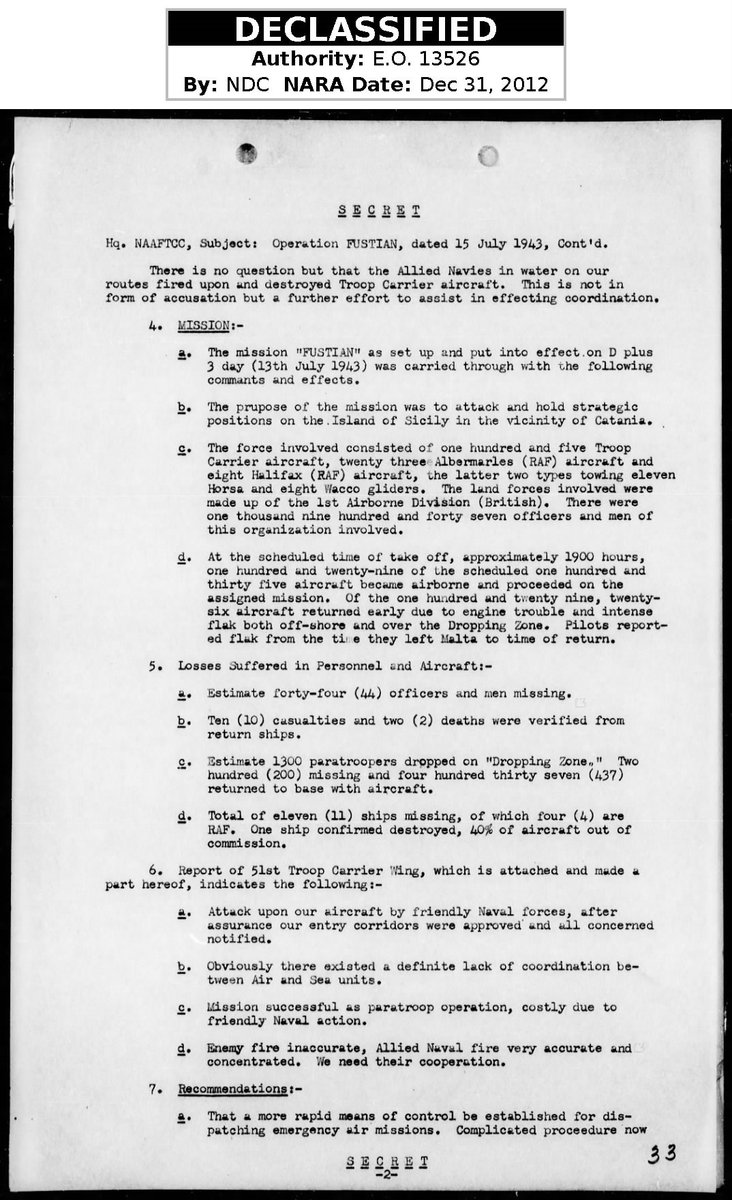Paul Woodage's [@WW2TV] had a very nice video stream today with Kevin Hymel using information from his forthcoming book on Gen Patton.
This thread will expand on a piece of it regards Operation Huskey's friendly fire incident that killed 400 troops
1/
This thread will expand on a piece of it regards Operation Huskey's friendly fire incident that killed 400 troops
1/
Operation Huskey's 2nd set of air drops resulted in 23 C-47 & C-53 troop carriers, & some gliders, being shot down with 400 US & UK paratroopers plus air crew aboard them.
2/
amcmuseum.org/history/a-very…
2/
amcmuseum.org/history/a-very…

The friendly fire incident was due to the lack of a plan for centralized control of fleet and the just landed shore based anti-aircraft weapons.
The Report of Allied Force Airborne Board on Operation “HUSKY” is online (link)
fold3.com/image/1/270149…
3/
The Report of Allied Force Airborne Board on Operation “HUSKY” is online (link)
fold3.com/image/1/270149…
3/
These are pages 32, 33, & 34 of the 42 pages of "The Rpt of Allied Force Airborne Board on Op. “HUSKY” on Fold3.com.
Short form - The Allied Navies were given time, course & speed of the paradrop when agreed & they didn't pass the information on in time.
4/


Short form - The Allied Navies were given time, course & speed of the paradrop when agreed & they didn't pass the information on in time.
4/



Every single Allied invasion convoy the troop transport stream flew near shot at them.
This was a comment at the end of the report:
"C-in-C A.F.H.Q.
I am in general agreement with this report. To my opinion the operation as planned was not operationally sound. It involved
5/
This was a comment at the end of the report:
"C-in-C A.F.H.Q.
I am in general agreement with this report. To my opinion the operation as planned was not operationally sound. It involved
5/
...the troop carrier flying along some 35 miles of actual front. Even if it was physically possible for all the troops and ships to be duly warned, which is doubtful, any fire opened either by mistake or against any enemy aircraft would almost certainly be supported by all
6/
6/

...troops within range — AA firing at night is infections and control almost impossible.
s/
A. Tedder"
Captain E.W. MacMillan, one of the fighter controllers in Operation Husky amphibious landing fleet, begged to differ.
7/
s/
A. Tedder"
Captain E.W. MacMillan, one of the fighter controllers in Operation Husky amphibious landing fleet, begged to differ.
7/

Captain E.W. MacMillan taught a USAAF course titled "Fighter Control and Aircraft Warning in Amphibious Operations" in January 1945 at the AAF School of Applied Tactics, AAF Tactical Center, Orlando, Florida.
His course materials are on-line.
cgsc.contentdm.oclc.org/digital/collec…
8/
His course materials are on-line.
cgsc.contentdm.oclc.org/digital/collec…
8/
This is the Gela Beachhead Fighter Control graphic for Operation Husky. The ships marked "Sector" are to act as Fighter Sectors. The Sector ships L to R were USS Biscayne, USS Samuel Chase and USS Ancon. The Flagship is USS Monrovia w/USAAF Air Defense Control Center.
9/
9/

The graphic was created by Capt. MacMillan for his course. He was on the USS Monrovia the night when the 82nd Airborne Division was blown out of the sky.
Pretty much anything that could go wrong with communications did, at the worst possible time.
10/
Pretty much anything that could go wrong with communications did, at the worst possible time.
10/

But Capt. MacMillan's front line lesson learned as to the No. 1 factor in killing those paratroopers & air crew was the lack of a centralized amphibious anti-aircraft control authority.
The attached slide is the transcribed text from his JAN 1945 course.
11/
The attached slide is the transcribed text from his JAN 1945 course.
11/

Capt. MacMillan explained later in his course that the Navy & Ground AA liaison officers were placed on USS Ancon for the Operation Avalanche landings at Salerno, Italy and fixed most of the friendly fire problems compared to Operation Husky.
This command set up was used at
12/
This command set up was used at
12/
...Anzio, Normandy and Southern France.
None of these lessons learned from Europe made it to the USN in the Pacific. Much to it's regret when the Japanese kamikazes came calling.
/End

None of these lessons learned from Europe made it to the USN in the Pacific. Much to it's regret when the Japanese kamikazes came calling.
/End


• • •
Missing some Tweet in this thread? You can try to
force a refresh







